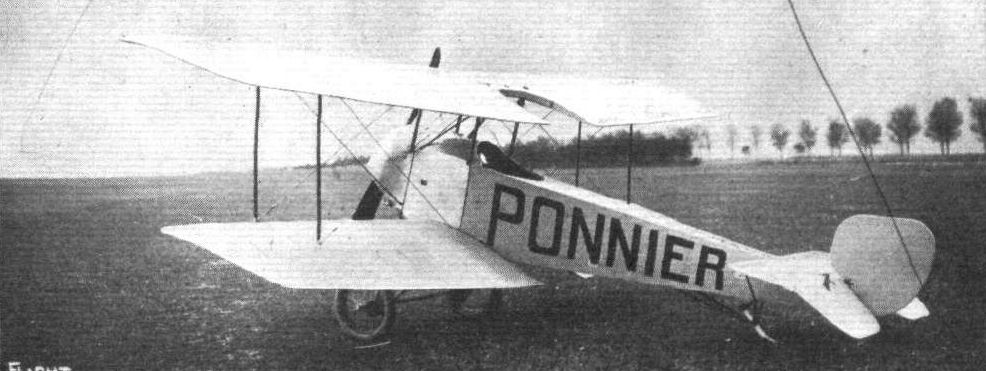L.Opdyke French Aeroplanes Before the Great War (Schiffer)
Deleted by request of (c)Schiffer Publishing
Ponnier also built a small 2-seater trainer, Type Ecole, in 1914. It had a 3-cylinder engine and an uncovered fuselage supported by a 4-legged undercarriage. In July 1914 the firm offered the LI, also a Type Cavalrie, a small single-seater biplane with a 50 hp Gnome.
(Span: 8 m, 7.2 m; length: 5.5 m; wing area: 20 sqm; weight empty: 260 kg)
Журнал Flight
Flight, August 14, 1914.
THE PONNIER SCOUTING BIPLANE.
UP to the time of the winning, by Pixton on the small Sopwith biplane, of the Schneider Cup, French designers confined their attention, when high speeds were desired, to the monoplane type of machine. Their efforts in this direction were crowned with a considerable amount of success, as evidenced by me performances of the Deperdussin and Ponnier monoplanes, piloted by Prevost and Vedrines respectively, in last year's Gordon-Bennett race at Rheims. But whereas the maximum speed attained by these racing machines was very high, the speed variation was practically negligible, and it was not until the excellent performances of the Sopwith biplane brought home very forcibly to French designers the possibilities of a small, fast biplane, that this type was taken up in France. Since then, however, several French constructors have, at the request of the Government, we believe, produced scouting biplanes of the type originated in this country by the Sopwith Aviation Co., Ltd.
In the case of the Ponnier biplane, of which we publish illustrations this week, the step from monoplane to biplane was not a very long one, since the particular type of fuselage employed in the former was eminently suitable for the latter. Practically the only alteration necessary was that of substituting two pairs of wings for one pair, and arranging them in such a manner that the balance of the machine was preserved, and the scouting biplane was evolved.
The fuselage is identical with that of the cavalry type monoplane exhibited at the last Paris Aero Show, when it was fully described in our columns. It is of rectangular section and built up of four ash longerons connected by struts and cross members, the whole being made rigid by means of the usual cross wiring. In front the longerons converge until they meet the rear engine-bearer. From here the tubular extensions of the longerons are swept outwards to clear the engine and carry on their front extremities the front engine-bearer, which is of the usual pressed steel type.
As in the monoplane, the fuselage is entirely covered in, the rear portion being covered with fabric, whilst the nose of the machine up to the pilot's seat is enclosed by aluminium sheeting, the front portion of which forms a cowl over the front and upper half of the engine. At present a 50 hip. Gnome is fitted, but by slightly enlarging the cowl an 80 or 100 h.p. Gnome could easily be accommodated.
In plan view the main planes are similar to those of the Ponnier monoplane, tapering considerably towards the tips. In section they are characterised by a Philips entry, and a very pronounced return of the trailing edge. The wings are unusually thick, and thus allow of fitting spars of great depth, which again makes for strength of construction, and enables the number of interplane struts to be reduced to two on each side. These struts are steel tubes of excellent streamline section, and cross bracing is effected by means of stout stranded cables, terminating in quick release devices, which greatly facilitate erecting and dismantling of the wings. The angle of incidence diminishes considerably towards the tips, a fact to which the constructors attribute, in great part, the stability of the machine.
The type of chassis employed in the Ponnier monoplane has been retained, and consists of two pairs of struts, each pair of which forms a V as seen from the side. The apices of the two V's are connected by a tubular axle, working in slots in a plate which is welded into the angle between the front and rear tubular struts. Lateral stiffness of the chassis is provided by cables running from the upper end of one chassis strut to the lower end of the strut opposite, as will be seen from the front view of the machine. Springing is by means of rubber shock-absorbers wound round the axle and anchored to a short length of steel tubing welded on to and projecting out from the apex of the chassis struts.
From the pilot's seat an exceptionally good view for a machine of this type is obtained. It is stated by the constructors that the downward angle of vision is 20°, or, in other words, that when the machine is flying at a height of 1,000 ft., the pilot is able to see the ground as far back as a point 400 ft. in advance of a point vertically below him. By cutting away the trailing edge of the centre portion of the upper plane, a good view is obtained in an upward direction, so that it is only in a forward and upward direction that the view is obscured.
Control is by means of a foot-bar for the rudder, and a rotatable hand wheel for warp and elevator. The fixed tail plane, which is of the flat non-lifting type mounted on top of the fuselage, is constructed of a framework of steel tubes, as are also the elevator and rudder. A tail skid of the type shown in one of the accompanying sketches, protects the tail planes against contact with the ground. The weight of the machine empty is 570 lbs., and the maximum and minimum speeds are 65 and 33 miles per hour respectively. With a 50 h.p. engine the machine climbs to an altitude of 1,000 metres (3,281 ft.) in 8 mins., with a load of 350 lbs.







